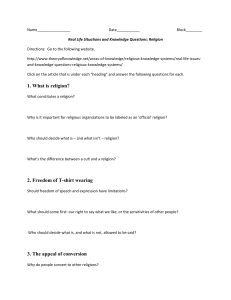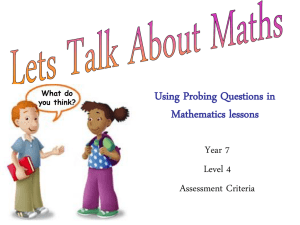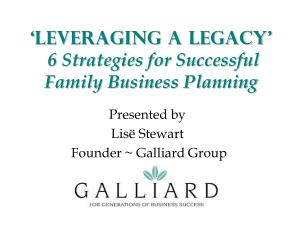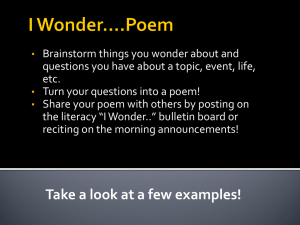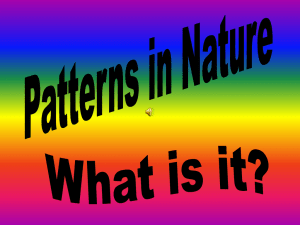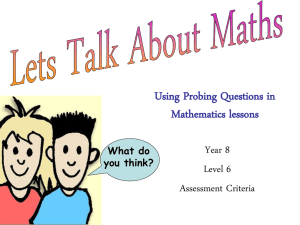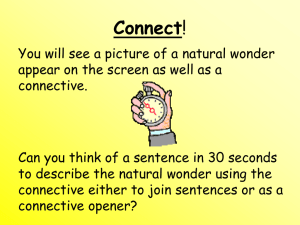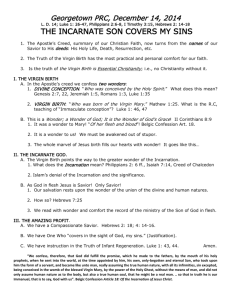Year 8 Level 5 Probing Questions Version A
advertisement
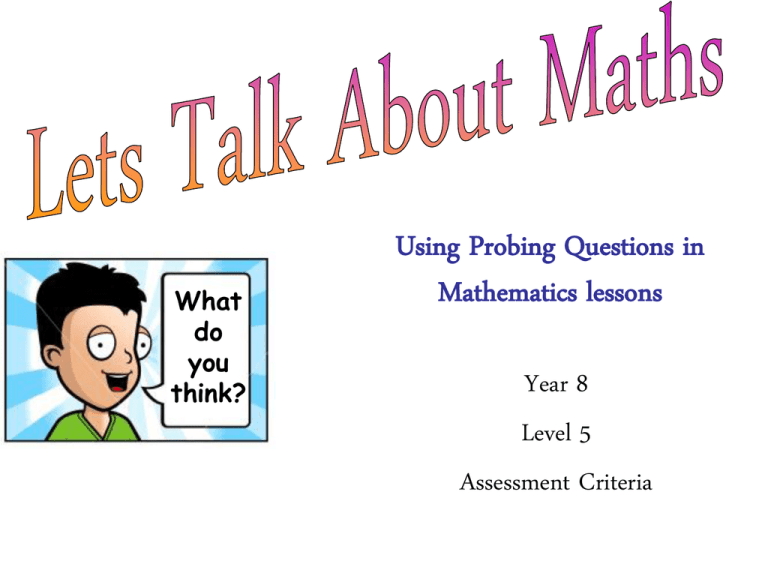
What do you think? Using Probing Questions in Mathematics lessons Year 8 Level 5 Assessment Criteria Click on a link to Jump to the Assessment Criteria you are looking for. Assessment Criteria for Year 8 Level 5 • Using and applying mathematics to solve problems • Numbers and the number system • Calculations • Algebra • Shape, space and measures • Handling data Using and applying mathematics to solve problems • Identify the necessary information to solve a problem; represent problems and interpret solutions in algebraic, geometrical or graphical form. There’s a lot of information there. I wonder what’s important? Bacteria in a petri dish double the area they cover every day. If the dish is full after 16 days, on what day was only one quarter of it full? I don’t think there’s enough information here I’m going to work out a quarter of 16. I wonder what the half time score was? 2 1 I’m going to work out all the possible half time scores. What would happen if the final score was different? Where do I start? A boy ate 100 cookies in total in five days. Each day he ate 6 more than the day before. How many cookies did he eat on the first day? I think I could use algebra. I’m just going to guess. I wonder if I could use symbols? Bugs Bunny has three carrots of lengths 10cm, 12cm and 15cm. How can he use these carrots to mark off a length of 17cm? I wonder what other measurements Bugs could get? I think I’ll draw a diagram. Numbers and The Number System • Add, subtract, multiply and divide integers. What about multiplying and dividing? I think addition always makes numbers bigger I think subtraction always makes numbers smaller! I think you’re both wrong! Did you use more than one operation? Hey! I got – 144. Did you use +, –, x or ÷ ? I can guess what keys you pressed to get that answer! What if x was a – 0.2? If x = 2, I can put these cards in order What order would they go in if x = – 2? Calculations • Use standard column procedures for multiplication and division of integers and decimals, including by decimals such as 0.6 and 0.06; understand where to position the point by considering equivalent calculations I know you’re wrong without even doing it! Hey, Look! 37 X 64 is 2366. Well I think she’s about right! If she’s wrong, how do you work it out without a calculator? I can work out a calculation that gives 23.68! Hey, Look! 64 X 37 is 2368. I wonder if there are other calculations that give 2368? Can you work out a dividing calculation that gives 3.7? Algebra • Simplify or transform linear expressions by collecting like terms; multiply a single term over a bracket. • Substitute integers into simple formulae. I can think of lots of expressions that give the same answer as this! 4p + 3q - 2 What do you look for when you have an expression to simplify? Do any of your expressions include brackets? There! I’m done! 4(a + 2) = 4a + 2 3(p – 4) = 3p - 7 -2(5 – m) = -10 – 2m I need some tips when you have to remove brackets. I think you made some mistakes! I can think of other expressions that give 6 – 8x I know what’s behind the Post It notes! 10 2x) = 6 – 8x 4(1 I wonder if something like this could make 6 – 8x? 10 4(1 2x) If I make x = 2, I can tell which cards match. Would it make sense if x = -3? Would they still match if I made x = 5? I think that when x = –1, y will equal –7. y = 5x - 2 The way these guys talk gets me all confused! “When x equals something then y equals something” WHAT!!??! I can think of another formula that give y = –7 when x = –1. Shape, Space and Measures • Transform 2-D shapes by simple combinations of rotations, reflections and translations, on paper and using ICT; identify all the symmetries of 2-D shapes. • Use units of measurement to estimate, calculate and solve problems in everyday contexts involving length, area, volume, capacity, mass, time, angle and bearings; know rough metric equivalents of imperial measures in daily use (feet, miles, pounds, pints, gallons). I can transform tile A2 using reflection then a rotation. What information do you need to rotate an object? How can I transform the First Pattern to the Second Pattern? I wonder what stays the same and what is different when you reflect objects? I can make up some hard questions about these containers! I know that 1 cm3 of water weights 1 gram. I wonder how much all this water weighs? How do you change millilitres to Litres? I think I know about how many pints this is. Handling data • Estimate probabilities from experimental data; understand that: – if an experiment is repeated there may be, and usually will be, different outcomes; – increasing the number of times an experiment is repeated generally leads to better estimates of probability. . I think all these dice are unfair. I don’t think you can tell which one is fair and which one isn’t fair. Here are the results of my experiments I don’t even understand this table! Thanks to Emile Pinco, Head of Mathematics at Churchdown School, for compiling this resource Based on material from the Secondary Strategy’s ‘Focused Assessment Materials’ (APP) and ‘Progression Maps’ Some images from www.stfx.ca
